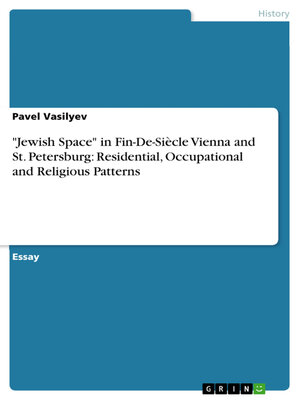"Jewish Space" in Fin-De-Siècle Vienna and St. Petersburg
ebook ∣ Residential, Occupational and Religious Patterns
By Pavel Vasilyev

Sign up to save your library
With an OverDrive account, you can save your favorite libraries for at-a-glance information about availability. Find out more about OverDrive accounts.
Find this title in Libby, the library reading app by OverDrive.



Search for a digital library with this title
Title found at these libraries:
| Library Name | Distance |
|---|---|
| Loading... |
Essay from the year 2010 in the subject History of Europe - Newer History, European Unification, grade: A-, University CEU San Pablo Madrid, language: English, abstract: At first glance, the historical Jews do not seem to have been a group that was determining the architectural, visual and spatial outlook of cities – in Europe or overseas alike. In fact, as Rudolf Klein put it, "the Jews were seldom in a position – save in ancient and modern Israel – to impose architecture on others"; partially because they "moved so many times in history that they lacked the preconditions for a continuous architectural evolution". Moreover, architecture has always been considered a Jewish 'specialty' much less then, say, literature, medicine or business. However, I will show that a closer look at the connections between the Jews and the urban space is an important and promising enterprise that tells us a lot about the Jews, the city – and also about Gentiles.
The focus of this paper is on the fin-de-siècle period (late 19th – early 20th centuries) and on the two capital cities of Vienna and St. Petersburg – and for some reasons. Both cities were capitals of the empires (Austria-Hungary and the Russian Empire, respectively), that were powerful enough to be a major military and financial competitors, but still technologically and economically backward. The transition to modernity in both capitals was late and problematic, and the Jewish communities have faced a long and persistent anti-Semitism. In both contexts, however, the Jews were especially successful and over-represented in the most modern professions – and also more visible in the rapidly changing modern urban space. Thus, this paper also compliments to the perspective that analyzes "Jewish space" in fin-de-siècle capitals – and brings a comparative element into the picture.
Accordingly, in this paper I will look at the Jewish experiences in turn-of-the-century Vienna and St. Petersburg to compare the visions, images and representations of the "Jewish space" in the two imperial capitals that were struggling through modernity. I am particularly interested in residential, occupational and religious aspects of the "Jewish space" as these were the factors that determined the everyday life cycle of particular Jews. Additionally, I want to trace the potential influence that the Jewish patterns of space organization may have exercised upon Gentile ones around turn of the century.







